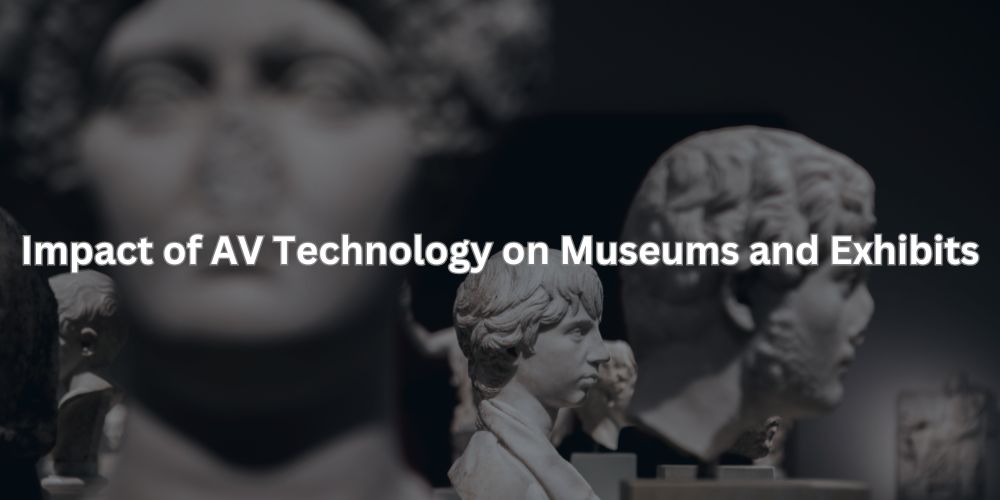
From Static to Spectacular: The Powerful Impact of AV Technology on Museums and Exhibits
The museums have long been treasured spaces where history, art, and science come alive, enabling the visitor to get the opportunity to explore and learn through curated exhibits. However, with the emergence of current technologies, these traditional static displays have yet to be able to capture the audiences of the present time, whose interaction with technology has been well-acquainted. Welcome to the audiovisual technology transforming how museums engage with their visitors.
Suppose the museum exhibits can be more engaging by incorporating audio, video, interactive screen facilities, and projection mapping into the display. In that case, the facility can leverage an enhanced storytelling experience. The transformation of static displays to a spectacular presentation, made possible with mood-enhancing audio and visuals, catches more visitors’ attention and allows a deeper rapport with scrutinized subject matter. Whether recreating historical events or creating completely interactive environments, AV technology could offer new levels of engagement unimaginable until now.
Understanding AV Technology in Museums
Audiovisual technology in interactive museums refers to using multimedia to enhance exhibits through sound, video, interactive displays, and projection systems. While traditional static displays were once the norm, today’s interactive museum design leverages AV technologies to transform spaces into dynamic environments that engage multiple senses, making content more impactful and accessible. For instance, digital projectors can turn exhibit walls into immersive scenery, while touchscreens allow visitors to explore detailed information at their own pace.
These technologies might include interactive audio guides or directional speakers offering personalized audio, improving understanding by providing context-specific explanations. This is not just about adding technology for the sake of it; rather, AV tools are essential storytelling devices that allow museums to present artifacts, history, and art in ways that deeply resonate with today’s tech-savvy audiences. The collaboration between cutting-edge interactive museum design and traditional curation can create museum exhibits that are both captivating and educational.
Benefits of AV Technology in Museum Exhibits
Improved Engagement
AV technology has enabled dynamic visuals and interactive displays that enthrall visitors at the Museum of Science and Technology. What was once a passively viewed exhibit has transformed into an active exploration. This shift nurtures better learning and retention of information, making each visit memorable.
Immersive Storytelling
By consolidating sound and video with projection mapping, the visitor is placed in the natural environments of a historical event, a cultural narrative, or a scientific concept, making any living story even more impactful.
Accessible Learning
AV technology supports various visual, auditory, and hands-on interactive learning styles, ensuring that more visitors can access the content than ever before. This inclusiveness is crucial for museums aiming to provide online museum exhibits free of charge, making education accessible to a broader audience.
Efficient use of space
Digital displays, projectors, and other audiovisual media can display much information without needing more physical space. Therefore, museums can communicate more in the same exhibition area.
Real-time updates
With digital content, museums would find it much easier to change information about an exhibit or even the exhibit itself without making extensive physical changes.
Critical Components Of AV Technology
Projectors and Displays
These are essential for creating interactive visual exhibitions. High-resolution projectors and digital screens can convert stationary walls into dynamic canvases for storytelling, crucial for both physical and virtual art gallery experiences.
Audio Systems
Good sound machinery, like directional speakers and audio guides, can allow visitors to hear individual audio. These could be background soundscapes, narrations, or other contextual auditory effects that might add atmosphere to an exhibit.
Interactive Touchscreens
Touch-sensitive screens allow visitors to interact directly with the content and, in return, receive more information, animation, or even games. This provides an active way of learning and allows for deeper exploration of the topics exhibited.
Light Control Systems
Intelligent lighting can draw people’s attention, highlight an artifact, or set the atmosphere of an exhibit. Indeed, dynamic light can further be complemented with audio and video effects to create a full-scale immersive experience.
Content Management Software
Special management software effectively stores digital media in museums on various devices so that exhibits remain timely, relevant, and easy to adapt.
Implementing AV Technology: Best Practices
Clear Objectives
Establishing clear goals for what the exhibit should achieve—such as enhancing storytelling, increasing interactivity, or improving accessibility—helps in selecting the right AV components for your Museum of Science and Technology.
Ensure Content Quality
High-quality audio, video, and interactive content are essential for a professional and engaging experience. Investing in well-produced multimedia elements and regularly updating them to keep exhibits fresh and relevant would be integral.
Prioritize User Experience
Designing an AV setup needs to be visitor-oriented; intuitive interfaces and clear instructions are expected for every interactive display. The feeling of being overwhelmed with overused technology needs to be avoided by achieving a balance between digital and physical.
Accessible
Provide subtitles, audio descriptions, and touchscreens that all visitors can use, regardless of their visual, hearing, or mobility impairments.
Maintenance and Update Plan
Periodically check and perform maintenance on AV equipment to avoid breakdowns or other technical problems. Keep updating the content management software so that any changes or updates in the content integration can be made.
Equipped with projectors, audio systems, interactive touchscreens, and intelligent lighting, museums today can introduce dynamic storytelling environments in native English. The stated best practices are to specify objectives, content quality, and user experience or access. Besides, partnering with a reliable AV technology provider will make all the difference in how such systems are implemented and cared for.
One of these highly recommended companies providing AV solutions is JVN Systems, considered one of the top companies in designing and integrating advanced audio-visual technology applications designed for the exacting needs of museums and exhibitions. By opting for a reliable partner like JVN Systems, a museum can be assured that its AV technology will enhance the visitor experience by being genuinely effective and future-proof.

